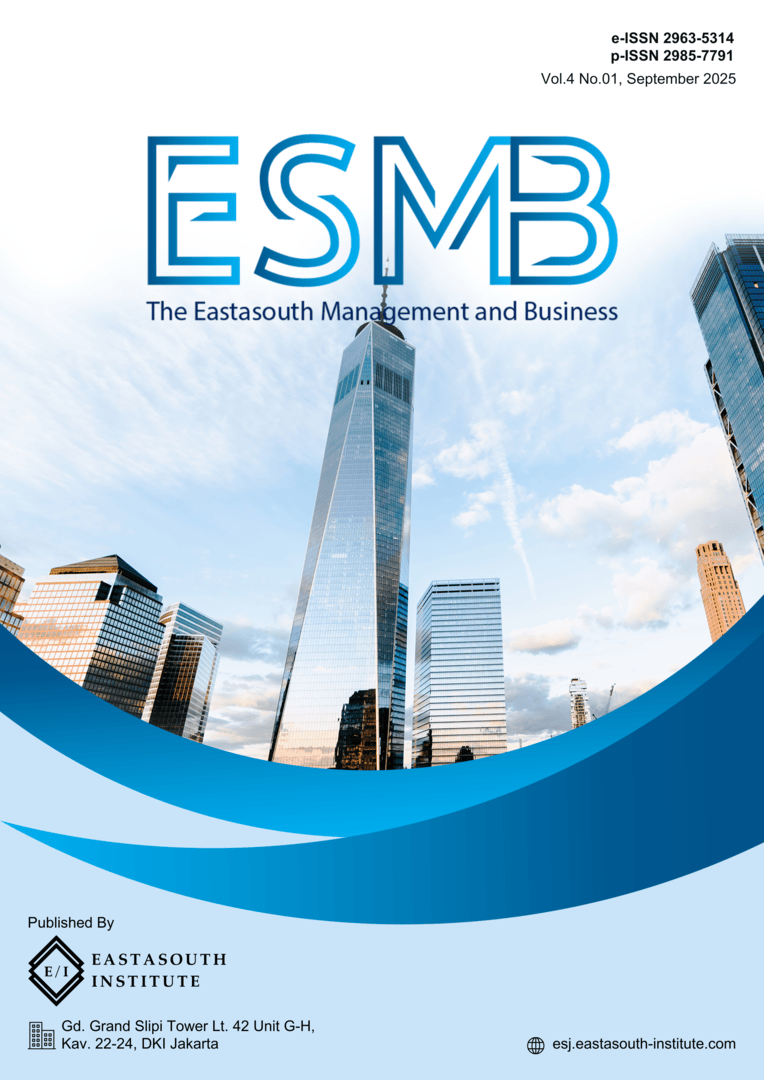Research Trends and Intellectual Structure of Business Impact Analysis: A Bibliometric Perspective
Main Article Content
Abstract
This study aims to map the evolution and intellectual structure of Business Impact Analysis (BIA) using a bibliometric approach with VOSviewer. Data were collected from the Scopus database, covering publications related to BIA and its intersection with sustainability, digital transformation, innovation, and artificial intelligence. The bibliometric mapping reveals that research in this area has increasingly shifted from traditional themes such as risk management and financial performance toward broader concerns, including sustainable development, environmental impact, and corporate governance. Keyword co-occurrence analysis highlights “sustainable development,” “innovation,” and “digital transformation” as central clusters, reflecting the growing integration of BIA into global sustainability and technological agendas. This study contributes to theory by expanding the conceptual boundaries of BIA research and provides practical insights for policymakers, organizations, and practitioners in enhancing resilience and competitiveness. Limitations include reliance on a single database and exclusion of non-indexed literature, suggesting avenues for future research.
Article Details

This work is licensed under a Creative Commons Attribution-ShareAlike 4.0 International License.
References
S. A. Torabi, H. R. Soufi, and N. Sahebjamnia, “A new framework for business impact analysis in business continuity management (with a case study),” Saf. Sci., vol. 68, pp. 309–323, 2014.
S. Radeschütz, H. Schwarz, and F. Niedermann, “Business impact analysis—a framework for a comprehensive analysis and optimization of business processes,” Comput. Sci. Dev., vol. 30, no. 1, pp. 69–86, 2015.
P. Sikdar, “Alternate approaches to business impact analysis,” Inf. Secur. J. A Glob. Perspect., vol. 20, no. 3, pp. 128–134, 2011.
S. Tjoa, S. Jakoubi, and G. Quirchmayr, “Enhancing business impact analysis and risk assessment applying a risk-aware business process modeling and simulation methodology,” in 2008 Third International Conference on Availability, Reliability and Security, 2008, pp. 179–186.
A. Hiles, Enterprise Risk Assessment and Business Impact Analysis:: Best Practices. Rothstein Associates Inc, 2002.
S. Williams and N. Williams, The profit impact of business intelligence. Elsevier, 2010.
G. Valiris and M. Glykas, “Business analysis metrics for business process redesign,” Bus. Process Manag. J., vol. 10, no. 4, pp. 445–480, 2004.
Q. Wang, T. Sun, and R. Li, “Does artificial intelligence promote green innovation? An assessment based on direct, indirect, spillover, and heterogeneity effects,” Energy Environ., vol. 36, no. 2, pp. 1005–1037, 2025.
L. Bednarski, S. Roscoe, C. Blome, and M. C. Schleper, “Geopolitical disruptions in global supply chains: a state-of-the-art literature review,” Prod. Plan. Control, vol. 36, no. 4, pp. 536–562, 2025.
R. N.-U.-D. Jalal, I. Alon, and A. Paltrinieri, “A bibliometric review of cryptocurrencies as a financial asset,” Technol. Anal. Strateg. Manag., vol. 37, no. 4, pp. 432–447, 2025.
J. Wang, L. Qiao, G. Zhu, K. Di, and X. Zhang, “Research on the driving factors and impact mechanisms of green new quality productive forces in high-tech retail enterprises under China’s Dual Carbon Goals,” J. Retail. Consum. Serv., vol. 82, p. 104092, 2025.
B. Obrenovic, X. Gu, G. Wang, D. Godinic, and I. Jakhongirov, “Generative AI and human–robot interaction: implications and future agenda for business, society and ethics,” AI Soc., vol. 40, no. 2, pp. 677–690, 2025.
N. Annesi, M. Battaglia, I. Ceglia, and F. Mercuri, “Navigating paradoxes: Building a sustainable strategy for an integrated ESG corporate governance,” Manag. Decis., vol. 63, no. 2, pp. 531–559, 2025.
S. Patanjali and N. M. K. Bhatta, “Work from home during the pandemic: The impact of organizational factors on the productivity of employees in the IT industry,” Vision, vol. 29, no. 3, pp. 326–338, 2025.
F. Ren, X. Liu, V. Charles, X. Zhao, and D. Balsalobre-Lorente, “Integrated efficiency and influencing factors analysis of ESG and market performance in thermal power enterprises in China: A hybrid perspective based on parallel DEA and a benchmark model,” Energy Econ., vol. 141, p. 108138, 2025.
V. Varriale, A. Cammarano, F. Michelino, and M. Caputo, “Critical analysis of the impact of artificial intelligence integration with cutting-edge technologies for production systems,” J. Intell. Manuf., vol. 36, no. 1, pp. 61–93, 2025.
G. B. Narkhede, B. N. Pasi, N. Rajhans, and A. Kulkarni, “Industry 5.0 and sustainable manufacturing: a systematic literature review,” Benchmarking An Int. J., vol. 32, no. 2, pp. 608–635, 2025.

